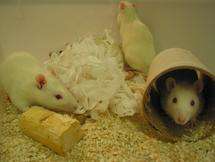Meet the complete mouse -- whole mouse genome sequence published

Are you a man or a mouse? A new paper, published in this week's issue of PLoS Biology, explores exactly what distinguishes our genome from that of the lab mouse. In the first comprehensive comparison between the genes of mice and humans, scientists from institutions across America, Sweden and the UK reveal that there are more genetic differences between the two species than had been previously thought. One-fifth of mouse genes are new copies that have emerged in the last 90 million years of mouse evolution. These large differences between genes in humans and the mouse are likely to reflect many of the differences that distinguish human and mouse biology.
These findings are reported in a landmark publication describing the finished genome sequence of the mouse, which, after the human, is only the second completed sequence for any mammal. That humans and mice have four-fifths of their genes in common - and that these genes have been identified - directly enhances scientists' abilities to pick out mouse genes that are most applicable to human disease. In effect, what this new research has shown is how to neatly separate biology that humans share with mice from biology found in one species only.
By filling in the gaps left by the previous version of the mouse genome, a vast treasury of new genes has been revealed. Many of these newly discovered genes are evolving at an unusually rapid pace, probably as a result of an evolutionary 'arms race' among mice and their reproductive cells.
"In retrospect, our previous picture of the mouse genome was incomplete. Only when all the missing pieces of the genomic puzzle had been filled in did we realize that we had been missing large numbers of genes found only in mice, and not in humans," says Dr. Leo Goodstadt from the MRC Functional Genomics Unit.
"These new findings are extremely important in helping us to separate genes that underpin biology that is the same across all mammals, from genes that make humans and mice so different from one another," says Prof Chris Ponting, from University of Oxford, UK, one of the leaders on this project.
"With the benefit of hindsight, we now see how incomplete our initial summary of the mouse genome was," adds Dr Deanna Church, National Center for Biotechnology Information at the US National Institutes of Health, who also led the project. "The painstaking work to complete it has been well worthwhile. The new findings will allow us to dismiss some commonly held misconceptions and, more importantly, to reveal many previously hidden secrets of mouse biology."
More information: Church DM, Goodstadt L, Hillier LW, Zody MC, Goldstein S, et al. (2009) Lineage-Specific Biology Revealed by a Finished Genome Assembly of the Mouse. PLoS Biol 7(5): e1000112. doi:10.1371/journal.pbio.1000112, biology.plosjournals.org/perls … journal.pbio.1000112
Source: Public Library of Science (news : web)














